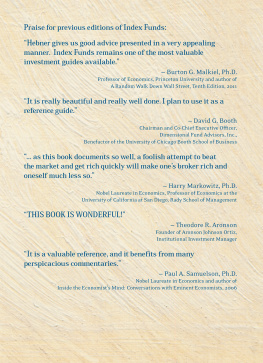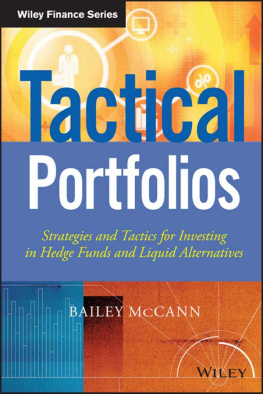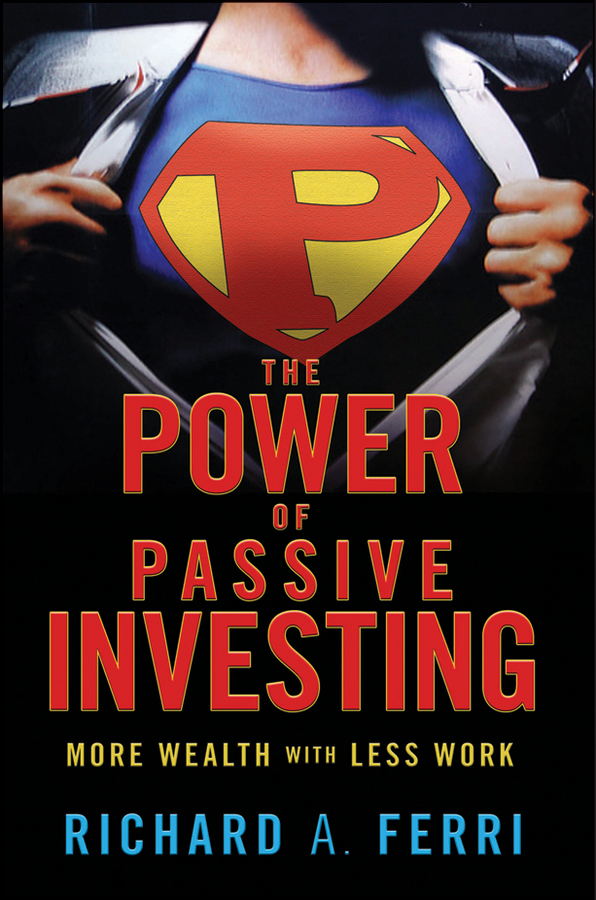Richard A. Ferri - The Power of Passive Investing: More Wealth with Less Work
Here you can read online Richard A. Ferri - The Power of Passive Investing: More Wealth with Less Work full text of the book (entire story) in english for free. Download pdf and epub, get meaning, cover and reviews about this ebook. year: 2010, publisher: Wiley, genre: Business. Description of the work, (preface) as well as reviews are available. Best literature library LitArk.com created for fans of good reading and offers a wide selection of genres:
Romance novel
Science fiction
Adventure
Detective
Science
History
Home and family
Prose
Art
Politics
Computer
Non-fiction
Religion
Business
Children
Humor
Choose a favorite category and find really read worthwhile books. Enjoy immersion in the world of imagination, feel the emotions of the characters or learn something new for yourself, make an fascinating discovery.

- Book:The Power of Passive Investing: More Wealth with Less Work
- Author:
- Publisher:Wiley
- Genre:
- Year:2010
- Rating:3 / 5
- Favourites:Add to favourites
- Your mark:
The Power of Passive Investing: More Wealth with Less Work: summary, description and annotation
We offer to read an annotation, description, summary or preface (depends on what the author of the book "The Power of Passive Investing: More Wealth with Less Work" wrote himself). If you haven't found the necessary information about the book — write in the comments, we will try to find it.
Time and again, individual investors discover, all too late, that actively picking stocks is a losers game. The alternative lies with index funds. This passive form of investing allows you to participate in the markets relatively cheaply while prospering all the more because the money saved on investment expenses stays in your pocket.
In his latest book, investment expert Richard Ferri shows you how easy and accessible index investing is. Along the way, he highlights how successful you can be by using this passive approach to allocate funds to stocks, bonds, and other prudent asset classes.
- Addresses the advantages of index funds over portfolios that are actively managed
- Offers insights on index-based funds that provide exposure to designated broad markets and dont make bets on individual securities
- Ferri is also author of the Wiley title: The ETF Book and co-author of The Bogleheads Guide to Retirement Planning
If youre looking for a productive investment approach that wont take all of your time to implement, then The Power of Passive Investing is the book you need to read.
Q&A with Author Rick Ferri
| Author Rick Ferri |
Passive investing is about achieving the returns you need in the markets by using low cost index funds and exchange-traded funds. Passive investing is all about earning your fair share of financial market returns whether the market is US stocks, international stocks, bonds, commodities, or any combination of those investments.
The opposite of passive investing is active investing. This is the act of trying to beat the markets by using an infinite number of higher-cost strategies that probably wont work. Nobel Laureates in Economics have been telling us for decades that passive investing is a better investment strategy than active investing. The Power of Passive Investing brings many of those studies together in one book.
How is this book different from your previous ones, such as The ETF Book, All About Asset Allocation, and All About Index Funds?
My previous books explain how to select low-cost index funds and ETFs, and how to create a portfolio using these funds. The Power of Passive Investing provides the proof about why this is a superior strategy to trying to beat the markets. The evidence in the book is irrefutable.
Who is the target audience of this book?
The Power of Passive Investing is written for any investor who wants to understand more about the mutual funds they are investing in, including people who have a 401(k) or similar work savings plan. Its also an important book for brokers and consultants who make a living recommending mutual funds and ETFs, as well as banks, trust departments and investment advisors who manage other peoples money. Finally, its a particularly important book for people who oversee endowments, foundations, and pension funds.
An observation you make is that while its possible to beat the market, its not probable. What are the odds a mutual fund will beat the market?
Mutual fund companies that try to beat the market argue that its possible to do so. They are right. It is possible; its just not probable, and the payout stinks.
Active managers often point to Warren Buffett, the famous CEO of Berkshire Hathaway as an example. They imply that since Warren beats the markets that we should believe that they, too, will win. Thats nonsense. Here are three reasons why it cant be true:
- About one-third of mutual funds go out of business every 10 years, and about 50 percent are defunct after 20 years. Only about 1 in 3 of the surviving funds outperform index funds. Surviving funds are the ones that dont close, and it assumes you know which ones those will be, which is not possible. The excess return from the winning surviving funds doesnt come close to the shortfall from the losing funds, and this is before accounting for the losses in the defunct funds before they closed.
Weve addressed one mutual fund versus one index and the low probability for active fund success. But thats doesnt define the whole problem because people dont own just one mutual fund. They own several funds across diversified asset classes such as US stock, international stock, bonds, real estate, and so forth.
Having several active funds in a portfolio exponentially lowers the probability that the portfolio will beat a comparable index fund portfolio. As more active funds are added, and the longer their held, the probability that a portfolio of index funds will outperform the active fund portfolio increases dramatically to the point where the index funds have a 99 percent probability of outperforming a comparable portfolio of active funds. Now thats something that all investors should consider!
Why do active investing strategies fail to beat the market for the vast majority of investors?
There are several reasons that active funds fail to deliver, not the least is the cost of trying to beat the markets. Hundreds of thousands of investment managers, investment advisors, brokers, mutual funds manager, pension funds managers, banks, trust departments, individual investors, traders, etc., are attempting to out-fox the markets. They spend hundreds of billions of dollars each year trading securities, paying managers and consultants, buying research, etc. The cost of trying to beat the market makes doing so impossible for most people.
A second reason investors fail to beat the market is due to poor behavior. They seek high returns by looking in the wrong places for outperformance. Active investors chase after past performance, they chase star ratings, and they chase the news. Theyre putting money in places today where they should have already had money. This tail chasing game costs investors dearly.
You make the case for low-cost index funds. But mutual fund fees arent the only cost. What other costs do investors bear?
There are trading costs, commissions, advisor fees, taxes, 12b-1 fees, administrative costs, research costs and the list goes on. Much of these costs are hidden from investors. For example, most investors in 401(k) plans dont provide investors good transparency on the costs theyre paying.
Another bastion of gluttony is high advisor fees. This issue is just starting to come out in the media. The typical investment advisor charges one percent per year to manage a portfolio of mutual funds for clients. Thats crazy-high given the huge advances in portfolio management software and other technology that have occurred over the years. Advisors today should be able to handle five times the amount of clients with half the amount of staff than they did in the 1990s. These productivity gains have not been passed on to clients in the form of lower fees.
What should investment advisers charge their clients?
Well, its not one percent, which is the standard fee youll hear in the marketplace. I believe Investors shouldnt pay more than 0.5 percent per year to an advisor, and probably less. My firm, Portfolio Solutions, charges only 0.25 percent in annual fees. Weve been charging this low fee for more than a decade, and it has saved our clients millions of dollars over the years. Thats real money is in their pockets.
Why do so many people try to beat the market if the proof that passive investing outperforms active investing is irrefutable?
Theres big advertising dollars promoting active management - much more than passive managers can afford. Remember, actively managed funds charge 5 to 10 times the fee of a comparable index fund. Much of this huge revenue stream is spent bombarding the public with nonsense about how active mangers can beat the market, and it basically ensures that the truth about passive investing gets lost in the noise.
Did you know that for every new book published on passive investing there are at least a dozen books published on how you can beat the market? Did you know that for every media interview with a passive investing advocate like myself there are at least 100 interviews with people who claim they can beat the market?
Its actually amazing to me that any information about passive investing gets to the public, and its a credit to investors who have looked beyond the smoke and mirrors.
How can someone adopt a passive investment strategy? Whats the first step?
The answer is to start learning the real facts about the markets and investing. You can start with The Power of Passive Investing if youre already knowledgeable about mutual fund investing. Ive also written several how-to books on low-cost index fund investing, exchange-traded funds, asset allocation and planning for retirement.
Richard A. Ferri: author's other books
Who wrote The Power of Passive Investing: More Wealth with Less Work? Find out the surname, the name of the author of the book and a list of all author's works by series.






